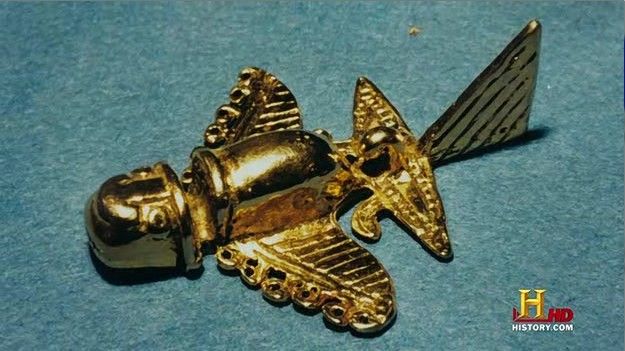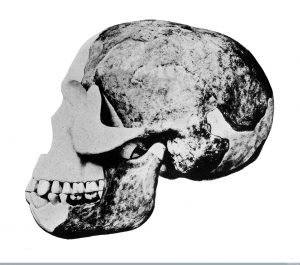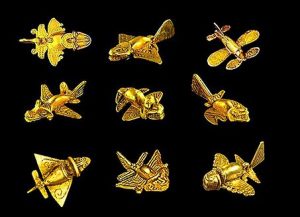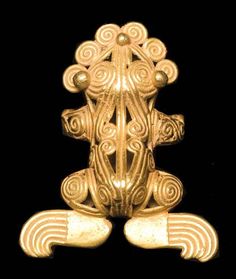
Pseudoarchaeological claims are also marked by frequent mention of “out-of-place-artifacts” often called “ooparts” for short. The notion by those that see fantastic explanations for these out-of-place-artifacts is that because the “X” artifact is found in “Y” context, “XX” culture must have put it there at “Z” time. Sometimes the artifacts are intentionally planted so as to create the conflict–hoaxes if you will; frauds if you prefer. Sometimes they are genuine artifacts, genuinely out of place, yet completely and innocently misunderstood.
Piltdown Man

Piltdown Man is a very well-known and thoroughly discussed example of an archaeological hoax. In fact, it is probably the most infamous of them all as one can hardly take a class in paleoanthropology, human evolution, or even archaeology 101 without reviewing it as a case study in bad science. The story of Piltdown has been told and retold so successfully else where that I’ll not attempt an in-depth discussion here. Instead, I offer a brief summary.
Originally named Eoanthropus dawsoni, (“Dawson’s dawn-man”), probably by Charles Dawson, who claimed the specimen was found by a gravel pit worker in 1908. Dawson presented it in 1912 to the Geological Society of London, who’s members were probably all-too-happy to have a major hominid find in the British Isles–particularly one that was just the “missing link” they expected. What made Piltdown unique, you see, was the combination of a human-like cranium with an ape-like jaw. It was thought, at the time, that the large brain came first with modern man and that the omniverous diet followed, making an ape-like mandible for grinding nuts and fibers necessary. As it turns out, the cranium and jaw were not just human-like and ape-like. They were exactly human and precisely orangutan! The cranium was finally shown to be from a person of medieval age and the mandible was that of an orangutan that died about 500 years before its alleged discovery in 1908.. The most likely culprit was Dawson himself, who had dozens of fraudulent specimens in his collection ranging from a fake Chinese vase made of bronze to filed down teeth alleged to be that of a reptile/mammal hybrid.
Ancient Colombian Jet Fighters
Not all out of place artifacts were intended to be evidence of fantastic claims. As early as the 5th century and as late as the 10th century CE, the Quimbaya culture of Colombia produced magnificent works of art in gold, among them a series of pendants and pins that depict animals and insects. Some of the animals depicted are of fish, such as flying fish or sharks. Others are of crocodiles, lizards, frogs, and wild felines. Many are of insects, probably moths, butterflies, and dragon flies. Hundreds of these small figures were created by the Quimbaya culture, perhaps to be worn as jewelry; perhaps intended only to accompany the dead. Most if not all were looted by tomb robbers prior to the 1970 UNESCO resolution to prevent illicit trade of antiquities and ended up in museums and private collections all over the world.

By the 1970s, perhaps earlier, some of these little pendants were being touted as evidence of ancient aliens. The fish and insects (truthfully, it’s difficult to tell them apart in some cases) look remarkably like jet airplanes. The Continuum section of Omni Magazine in the late 1970s even made the link to one of them being a rendition of NASA’s new space shuttle! In more recent times, the infamous Ancient Aliens program on the dubiously named History Channel featured at least one episode that linked these little gold pendants to proof of alien visitation in pre-Colombian times. Giorgio A. Tsoukalos, the bad-hair-guy pictured in all those memes you see on the Internet with the word “aliens” in quotes, said “about a dozen that are eerily reminiscent of modern day fighter jets.” Though he does admit the rest look like animals and insects.

The Quimbaya people, of course, had no concept of 20th century fighter jets and space shuttles. What they did have knowledge of was their environment. They paid keen attention to nature and were clearly skilled artisans. The renditions of animals like frogs and jaguars were stylistic and included abstract elements—sometimes in ways that were caricatures of their subjects: larger eyes, curly-cues on fins and feathers, large-bared teeth, and cross-hatch patterns on bodies and fins. There’s no denying the coincidence of a fish’s tubular body appearing to be similar to the fuselage of a fighter jet, the fins showing similarity with wing placements and proportions, or the tail fins showing similarity to the tail of a jet. But had a Quimbaya artisan shown his work for the first time to another Quimbayan, the recognition wouldn’t have been of a non-existent fighter jet. Rather, it would have been of a flying fish, a bull shark, or possibly even a sucker-mouthed catfish.

Occam’s razor states: among competing hypotheses, the one with the fewest assumptions should be selected. Scientists and researchers use this principle as a way to guide them to develop explanations that are simple and straightforward, reducing the chances for errors and bias along the way as they discover, explore, and explain. When it comes to the Quimbaya culture, assuming they would have created little gold pendants of fish in the same way they did frogs, crocodiles, and jaguars is a far more simpler explanation—one that requires so fewer assumptions—than claiming that a small percentage of their art represents the “fighter jets” of ancient aliens who visited the Quimbaya. The alien hypothesis includes several assumptions that defy testing and create complications.
Some of these assumptions are:
1. Of the 100 billion or so stars in the galaxy, aliens chose to visit ours.
2. Somehow ancient cultures were of special enough interest to visit (expending what must be tremendous resources, time, and energy) and interact with, but not contemporary cultures.
3. Aliens visit the Quimbaya people and the only depictions of their visits by the Quimbaya are fish-like representations of their “fighter jets.”
4. The Quimbaya people were incapable of or at least chose not to create representation of fish, birds, or insects but were extremely talented enough to create figures of the rest of the animal kingdom.
Each of these assumptions must be true in order for the ancient alien hypothesis to be accepted with regard to the Quimbaya sculptures. One could argue that we’re being visited in contemporary times, but that evidence is lacking and, depending on what is believed about modern alien visitation, a whole new set of assumptions would be presented. One might also argue that the Quimbaya people represented aliens and their craft in other ways that have yet to be discovered, but why would a culture visited by aliens only make perhaps a dozen or so that show their ships but create hundreds depicting animals they see every day?. If the answer is that they held higher reverence for animals, would this not mean they are more likely to depict fish, birds, and insects? If even a single “fighter jet” is accepted as a fish, bird, or insect, then one must consider that all of them cold be.
Conversely, the hypothesis that the Quimbaya people represented the fish, birds, and insects they encountered every day really only consists of one additional assumption if we accept that they actually fashioned frogs, crocodiles, and jaguars. And that is that they were interested enough to do it. Not only is this a very parsimonious explanation, but it’s one that gives credit where credit is due: to the Quimbaya people and their artistic abilities. Their figurines of gold and other materials were stylish and often abstract, but they were gorgeous works of art whether or not they were intended to be. The Quimbaya people were consummate observers of nature and reflected what they saw in caricaturizations that we can still admire today.
From the perspective of true believers in ancient aliens, my words above are coming from the “mainstream” and I’m sure they would argue that I haven’t an “open mind.” These are among the many buzzwords and concepts to look out for with pseudoarchaeological explanations.
Leave a Reply
You must be logged in to post a comment.